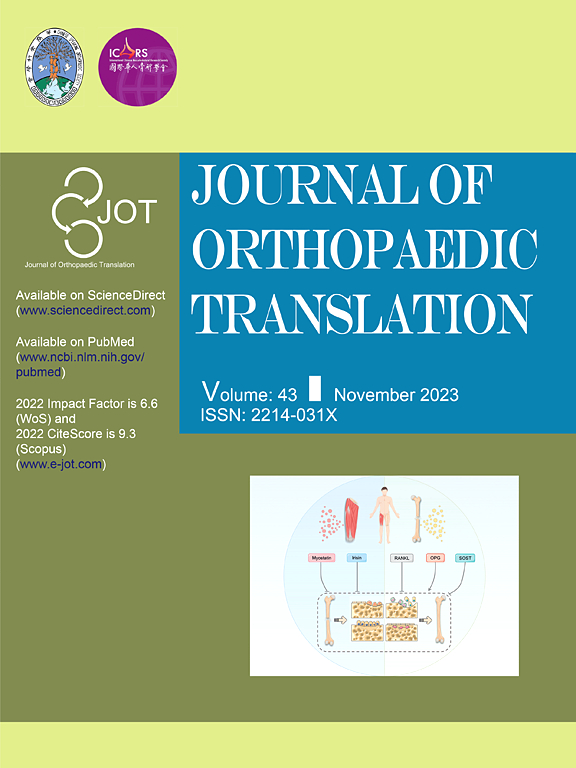Silence of HOTAIR promotes osteogenic differentiation and accelerates distraction osteogenesis by mediating FTO ubiquitination
IF 5.9
1区 医学
Q1 ORTHOPEDICS
引用次数: 0
Abstract
Background
Distraction osteogenesis(DO) is a valuable bone regeneration technique, yet its prolonged consolidation phase often entails pain, high costs, infection risks, and lifestyle disruptions. Finding adjunctive approaches to shorten treatment duration is thus of clinical significance. Long noncoding RNAs have been demonstrated to play pivotal roles in regulating bone formation, and homeobox transcript antisense intergenic RNA(HOTAIR) was also reported to regulate osteogenesis and bone formation. However, its role in DO remains unclear.
Methods
The effects of HOTAIR on osteogenesis were examined in rat bone marrow-derived mesenchymal stem cells(BMSCs) by asssessing ALP activity, calcification, and osteogenic gene expression with HOTAIR knockdown or overexpression. Using a tibial DO model, HOTAIR-stably silenced BMSCs or control cells were locally injected into the percutaneous distraction gap, and the effects were evaluated by micro-CT, dual-energy X-ray examination, mechanical testing, hematoxylin and eosin staining, and immunohistochemistry.
Results
In the present study, it was found that HOTAIR silence promoted while its overexpression suppressed the osteogenic differentiation of BMSCs. The Mechanistic study revealed that HOTAIR physically interacted with FTO, and disrupted FTO ubiquitination and degradation, leading to FTO up-regulation and suppressing osteogenesis. Using DO animal model, HOTAIR-silenced BMSCs stimulated new bone formation and accelerated DO healing in vivo.
Conclusion
Silence of HOTAIR enhanced osteogenesis in BMSCs and facilitated DO healing by recruiting FTO and inducing its degradation.
Translational potential
The findings generated from this study suggest that inhibitor of HOTAIR may be developed as a promising strategy for DO patients.

HOTAIR沉默通过介导FTO泛素化促进成骨分化,加速牵张成骨。
背景:牵张成骨术(DO)是一种有价值的骨再生技术,但其巩固期延长往往带来疼痛、高成本、感染风险和生活方式中断。寻找辅助方法缩短治疗时间具有重要的临床意义。长链非编码RNA已被证明在调节骨形成中起关键作用,同源盒转录反义基因间RNA(HOTAIR)也被报道调节骨形成和骨形成。然而,它在DO中的作用仍不清楚。方法:观察HOTAIR对大鼠骨髓间充质干细胞(BMSCs)成骨的影响,通过观察其ALP活性、钙化程度和HOTAIR敲低或过表达成骨基因的表达。采用胫骨DO模型,将hotair稳定沉默的骨髓间充质干细胞或对照细胞局部注射到经皮牵张间隙中,并通过微ct、双能x线检查、力学测试、苏木精和伊红染色、免疫组织化学评价其效果。结果:本研究发现HOTAIR沉默促进骨髓间充质干细胞成骨分化,而过表达抑制其成骨分化。机制研究表明,HOTAIR与FTO发生物理相互作用,破坏FTO的泛素化和降解,导致FTO上调并抑制成骨。在DO动物模型中,hotair沉默的骨髓间充质干细胞在体内刺激新骨形成并加速DO愈合。结论:HOTAIR沉默通过募集FTO并诱导其降解,促进骨髓间充质干细胞成骨,促进DO愈合。转化潜力:这项研究的结果表明,HOTAIR抑制剂可能成为治疗DO患者的一种有希望的策略。
本文章由计算机程序翻译,如有差异,请以英文原文为准。
求助全文
约1分钟内获得全文
求助全文
来源期刊

Journal of Orthopaedic Translation
Medicine-Orthopedics and Sports Medicine
CiteScore
11.80
自引率
13.60%
发文量
91
审稿时长
29 days
期刊介绍:
The Journal of Orthopaedic Translation (JOT) is the official peer-reviewed, open access journal of the Chinese Speaking Orthopaedic Society (CSOS) and the International Chinese Musculoskeletal Research Society (ICMRS). It is published quarterly, in January, April, July and October, by Elsevier.
 求助内容:
求助内容: 应助结果提醒方式:
应助结果提醒方式:


